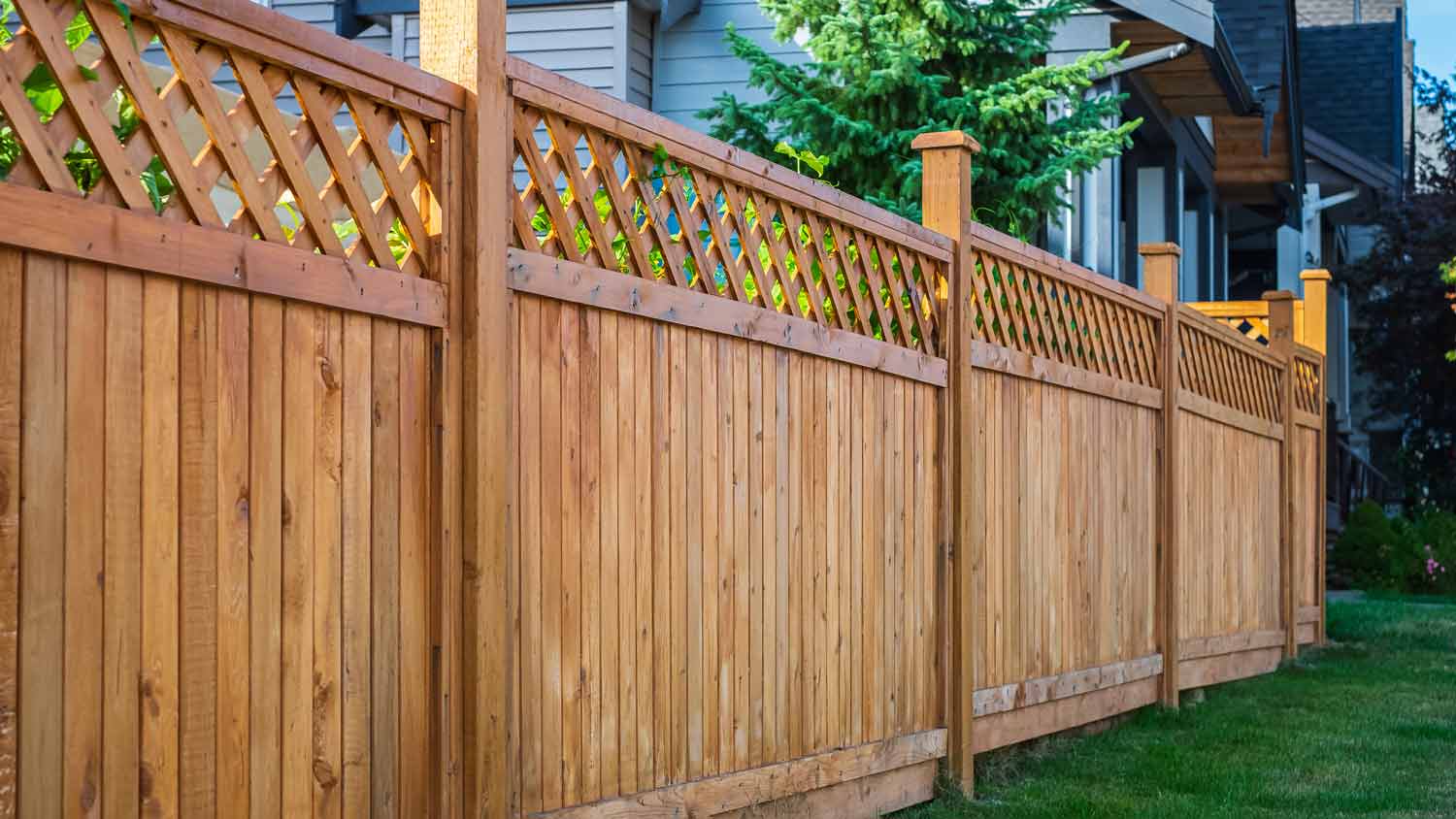
Fence repair costs depend on the extent of damage, your fence's material, and how much of the fence you need to fix. Explore all the price factors in this guide.
Get your gate on without losing your mind


Gates help increase security and privacy, and they look good doing it. However, gate installation is easily misunderstood, leaving most homeowners scratching their heads. That’s where we come in. There is a relatively simple and cost-effective method for hanging a gate on your property. Keep reading to learn how to install a gate with minimal muss and nearly no fuss.
Preparation is critical to ensure the project goes smoothly and that you end up with a perfectly installed gate. Here are some preparatory steps worth considering.
Measure first and buy later - Don’t just head to the hardware store and pick up a prefabricated gate or materials to build a gate. Before that, conduct the proper measurements to ensure the gate perfectly matches the pre-existing fence in both height and width.
Pick the right spot - Gates can technically go anywhere along the perimeter of the fence, but that’s just part of the story. When selecting a spot to hang a gate, prioritize sturdy ground free from obstructions. Also, you want an accessible route from the gate to your house.
Don’t forget the posts - While the gate itself should match the height of the fence and the width of the opening, the same isn’t entirely true of gateposts. With light gates, use gateposts around 1 to 2 feet longer than the gate. With heavy gates made from ultra-durable materials, choose posts 18 to 30 inches longer than the gate. When in doubt, follow the manufacturer’s instructions.
Go for prefab if possible - Depending on the width of your opening, you’ll likely be able to install a prefabricated gate. This cuts down on the installation time, as most of the components are already attached. Additionally, you won’t have to, you know, build a gate out of various materials.
Choose weatherproof components - Gates sit outside and are subject to weather conditions. To avoid rust, choose components that have been lacquered or galvanized. This is true of screws, hinges, and various fittings.
Your first step is to dig holes for the gateposts. Use a dedicated post-hole digger for this task and measure ahead to ensure the holes are exactly where the posts will go. For this, measure the gate itself and add the width of the posts to arrive at the total measurement, which will direct you to where the posts will go. Drive the digger into the ground and set aside the soil you collect for later. Keep going until you have two holes that are around 30 inches deep. The deeper you go, the sturdier the gate will be. If you encounter obstructions while working, like bricks or rocks, use a digging bar to loosen and remove them. Finish off by adding a bit of soil and using the rounded end of the digging bar to compact the soil at the bottom of each hole. As a note, add a few inches to the hole if you live in a cold climate to account for the freeze/thaw cycle.

Now, it’s time to place the hinge posts in the holes you dug. Some attach the posts to the gate before this step, but that method limits your adjustment options. Place each post in the appropriate hole and fill in with some of the remaining soil you saved from the previous step. Use enough soil here to keep the posts plumb in both directions, typically a few inches, grabbing the rounded hole of the post digger or a related tool to drive it deeper into the ground. Finally, snag your level to ensure that each post is at the same height. Double-check this because there will be no going back after the next step.
Next, it’s time to mix and lay down some concrete. Pour the concrete into a wheelbarrow and mix it with water according to the instructions. Ensure the water is evenly spread throughout the mix, but don’t let it get too wet. Once mixed, fill the first post evenly with concrete until it's 3” below grade. Use a piece of scrap wood to compact the concrete and remove any lingering air bubbles. Do the same with the second post, but use the same board and a level to triple-check that both post heights are the same. Once plumb, use a scrap board the width of the finished gate as a spacer to keep the correct distance as the concrete sets.
Concrete takes around 48 hours to set, but this installation method allows you to keep working, as the whole thing will set after the gate is hung. However, you can wait out the two days to ensure stability.
Now it’s time to attach hinges to the gate sections. Use a power drill to attach the hinges to the gate sections according to the instructions that accompany the gate. Go slowly during this part of the job to minimize any risk of splitting the opposite side of the gate, in the case of a wood gate. For metal gates, there isn’t that much of a risk. Most gates ship with the appropriate hinge hardware, with many featuring screw-in hinges. You can do this and skip the drilling, but we recommend going the extra mile and tossing the screws. Instead, use ¾-inch, all-thread hinge bolts that allow for adjustments later as the gate changes with time.
You made sure that the posts stand at an equal height, but the gate itself might benefit from some height adjustments. Arrange the gate between the posts and adjust it up and down to suit your preference, though you may be limited depending on where the screw holes are on both the gate and the hinges. If you have multiple options here, make sure to make a mark in the exact position the gate will screw into the hinges. The clearance height is up to you, but you may want to, say, keep it low if you have pets. Remember to keep it high enough off the ground so it doesn’t touch anything as it swings open and closed.

Now the fun part. It’s time to hang that gate. Assuming you’ve been careful to this point, this step should go smoothly. Draft a friend or family member to help maneuver the gate into place and hold it as you connect it to the hinges and attach the lag screws or whatever connection hardware came with the gate. Screw in each hinge, keeping the gate steady as you go. The gate should look finished at this point, though you still have some work left to do.
If you plan on locking the gate, you will have to install some locking hardware. Most gates will ship with a drop rod and a lock, but you can install pretty much anything you want here. Go slowly and work methodically because you haven’t tightened anything yet, and that concrete is still setting. With some gates, the locking hardware comes pre-installed.
You are in the home stretch now. Grab your drill or screwdriver and go around each hinge and screw hole, tightening as you go. To help the gate stay in the same spot as the concrete sets, attach a simple wood support beam running lengthwise. You can add even more support here by using additional timber props that run diagonally across the support beam.
Once the concrete has fully set, after 48 hours, remove the support beam and timber props and test the gate. Open it up and close it, making sure it clears the ground and doesn’t get in the way of anything. Once you are satisfied, that’s it. Enjoy your finished gate and the added security it provides.
Hanging a gate can be easy or frustratingly difficult, depending on your fence, the yard layout and the materials that comprise the gate. Here are some tips to make sure the installation process goes smoothly.
Work in reverse - There is an argument to be made for attaching the posts to the gate before you install anything else. This is the preferred method when hanging a double gate, as you can rest one portion of the gate against the wall as you work.
Hinge goes down - When in doubt about where to place a hinge, remember that it should always face down.
Consider washers and nuts - You may have to adjust the hinges later to account for weather-related changes. This process is more straightforward when your hinge bolts have washers and nuts. Again, this assumes you are using your own bolts and not the kit that likely came with the gate.
Don’t skip the height adjustment phase - Making sure both the posts and the gate are at the same height is crucial, so give this step some extra attention.
Go slowly and keep a tutorial nearby - Hanging a gate can be difficult for absolute amateurs, so keep a tutorial video handy.
This isn’t a job for absolute newbies, so it helps if you have a fair amount of experience with gate latch types and other aspects of the project. You also need to make sure you have all of the relevant tools and materials on hand. You’ll likely already have many of the required tools, especially if you are a handy homeowner. If you are starting from nothing, however, it might be a good idea to contact a local gate installer. These pros will arrive with all necessary supplies and should finish the job promptly. Remember, gates are about privacy and security, so you want to make sure the job gets done right.
From average costs to expert advice, get all the answers you need to get your job done.

Fence repair costs depend on the extent of damage, your fence's material, and how much of the fence you need to fix. Explore all the price factors in this guide.

Discover how much wrought iron fence installation costs depending on factors like its size, thickness, design, and location.

Aluminum fence costs depend on your fence’s height, thickness, design, and length. Explore all the cost factors in this guide.

A fence is a great way to add privacy and style to your yard. Compare two common options, horizontal vs. vertical fences, to see which is right for you.

Unsure who to hire to install a wrought iron fence? Compare fence contractors and ornamental iron pros, see how installation works, and choose confidently.

Wondering how to fix a rotted end on a fence gate? Your best bet is to replace the entire post. This step-by-step guide walks you through that process.